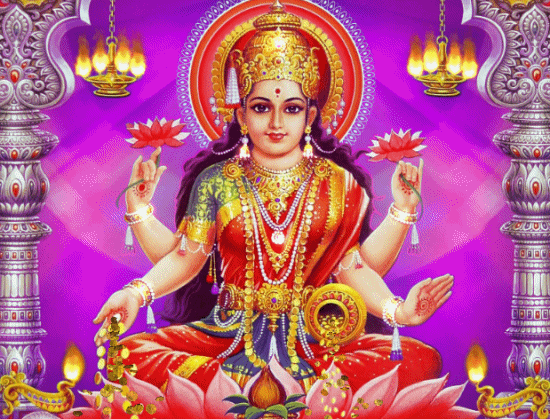
Abhishekam (Bathing God's idol)
Abishekam literally means bathing God's idol. During a traditional Puja, or worship ceremony, Abhishekam is often performed. In an Abhishekam, various liquids like water, milk, ghee, rose water, honey, sandalwood paste, tender coconut, a mixture of fruits etc., are poured in a steady stream over a divine idol holy and heavely being. While specific Sanskrit mantras are recited, divine blessings radiate out towards all those present, providing protection, purification, and spiritual elevation. These sacred ceremonies purify the Earth's atmosphere, uplift the community, and contribute to the health and prosperity of the individual.
Vastram (Offering clothing)
A decorative and beautiful piece of garments is offered to the idol. Later, flowers and jewels are also used to dress the deity. Devotees sometimes offer this piece of clothing requesting God for their prayers to come true.
Poorna kumbham (Sacred vessel)
The sacred metal pot consists with water/rice and few species in it, and five specific mango leaves with coconut, flowers are top in its mouth. The pot situated in front of the chief deity before starting the puja. Symbolically it stands for mother goddess. The pot represents mother earth, the flowers represent the ornamentation, the rice in the bowl represents either the material wealth or the powers of the goddess or both and the coconut represents the divine consciousness.
Deepam (Offering Oil Lamp)
Deepam is the light in us, the element of deepam stands for fire. It is the light in us, the very soul that exists in us which we offer to the deity as acknowledgement of our surrender and devotion.
Pushpam (Offering Flowers)
Flowers stand for the good in us. The flowers grow out of water, so it stands for the element of water. We offer the deity the good that has blossomed in us.
Pazham/palam (Offering Fruits)
It is the fruit of our action which we are supposed to offer to God as a symbol of self-sacrifice and surrender.
Gandham (Offering Scents)
Gandham stands collectively for the desires (vasanas) and the desires we have for different things in life, which we are supposed to offer to the deity in order to become free from the cycle of births and deaths.
Kunkum and turmeric powder
The red powder stands for our emotions or for our inner wisdom. The turmeric powder stands for our inner purity and on the negative side, for our inner pride and egoism.
Naivedyam (Offering Food)
Offering food (Naivedyam) to the God is considered most auspicious. The food symbolically stands for the earth element and in human beings for the gross body. The food is prepared with great devotion and care to offer to the chief deity of the Puja. The prasadam placed in front of the deity for transformation. Cooked foods like Sweet Pongal, dry fruits etc are offered to the God in a pious manner. When it is blessed by the deity it becomes the bestower of knowledge.
Archana (Chanting holy names and Mantras)
A worshiper will make offerings like fruits, flowers, coconut, beetle leaves etc. The worshiper will then receive the food offerings back in the form of prasad from the Deity. Different types of flowers are used to offer Archana to the God. The sacred priest chants suitable mantras while simultaneously performing the Archana. Also various names of the Almighty are called upon to strengthen the prayers of the devotees. Ashtothra archana, shahasranama archana etc., all are the special kinds of archana.
Dhoopam (Offering Incense Stick)
- Dhoopam are offered after Archana to the chief deity. It is clouded consciousness; we offer dhupam to God symbolically our illusions and our fickle mindedness. Dhoopam stands for the element of air or the breath body in us. It stands for prana which we offer to the deity with a sense of sacrifice.
Aarthi (Camphor) offering)
The aarthi is the part of a Puja where in a camphor is lit and waved to the idol of the deity to the accompaniment of the brass bell. After it waved in the direction of the idols, all the members of the family take turns to almost touch the flame with deep reverence.
Sankalpam (Declaration of intent)
The most important part of puja is Sankalpam. The entire ceremony is carried along with the strong will and wish of the participants. Each Puja is performed for a definite purpose; and it is this purpose that the performer and participants clearly hold within their minds as they take Sankalpa. It is at this time that the participants of the sacred Puja get to pray for their wishes like "Give me a child, Peace of mind, Bright future…."

